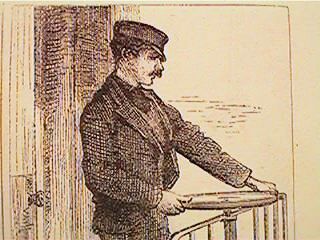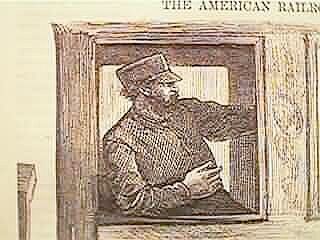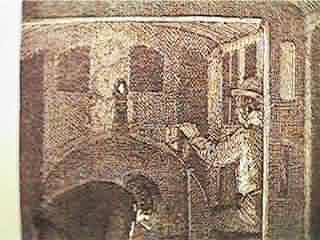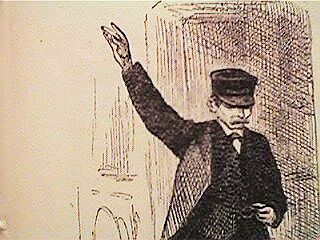

On every freight train there are two or more brakemen. The disagreeable features of their experience result mainly from severe weather, although they have much trouble with tramps.
In running on ascending grades or at a slow speed, the brakeman can ride under cover, but on descending grades or when running fast, he must be on top, ready to apply the brakes instantly.
When a train is unexpectedly stopped on the road, the rear-end brakeman takes his red flag or lantern and hurries back half a mile to give the stop signal to any train which may be following.
Another duty of the brakeman is to couple the cars, uncoupling being generally devolved on the freight conductors. Both these tasks are dangerous and result in the loss of many lives.

The brakeman is on hand promptly at the hour of preparation for departure, and has a brief period of lively work in assembling the cars from different tracks, changing the cars from the front to the rear or middle of the train, and setting aside those that are broken or disabled.
During much of his trip-time in the pleasant months of the year, the freight brakeman has an opportunity to get acquainted with farmers, from whom he buys good things at low prices and lives on fine fruit, vegetables, etc.
The passenger brakeman has to deal more or less with the public, and his chief duties are those of a porter. On the modern "limited" trains his day's work consists of a three hour's run without stop.
Occasionally the passenger brakeman must go back to "flag." In former days he was credited with much flirting along the run, and he has not altogether outgrown it. If he does well he will become a conductor.
The locomotive foreman usually serves an apprenticeship as an engine wiper in the roundhouse. Sometimes he also empties the clinker pits and performs other types of drudgery. If his work is satisfactory, he is in course of time placed on the extra-fireman list. If he continues to make himself useful, he is, after a while, promoted to be a regular fireman.
Many railroads require, on the part of their firemen, a good common-school education, and subject them to an examination in certain branches.
When the fireman is about to make his regular trip, he reports to the roundhouse, draws the necessary supplies, and sees that the lubricators, lamps, oil cans, tank and sand boxes are filled. If he uses soft coal he sees that it is broken and wet down; that the cab and its fittings are wiped, and the ash-pan cleaned, and that the grates are straight to keep the coal from dropping through. He then compares his watch with that of the engineer.
There are two systems of firing. In the banking system, used with coal having few clinkers, a large quantity of coal is placed in the firebox, so that the gases and hydro-carbons may be expelled and the coal may become coke. This is little used. The spreading system requires that the coal be broken into pieces about the size of a large apple.
In starting the fireman sees that the coal is well ignited, so that he need not open the firebox until the train has gained considerable headway, and the lever has been hooked up, with consequent lighter pull from the exhaust. 
In approaching a stopping point, he shuts down the dampers, and if fresh coal has been recently applied he opens the blower and leaves the firebox door slightly ajar, to prevent the escape of smoke and gases.
The fireman is the engineer's assistant, and is liable in an emergency to assume the latter's duties, or to take charge of another engine. To a considerable extent, it has been the usage among railway systems to allow engineers to select their own firemen, as it is important that these two trainmen shall be on the best of terms. The selection is subject, however, in a general way, to the assent of the master mechanic.
The work of the engineer and fireman is difficult and dangerous, and requires keen vigilance, close assuidity and iron nerve.
The locomotive engineer and the train dispatcher hold the two most responsible positions on the railroad. The former clings to the throttle, the latter sits before a train sheet in the dispatcher's office and regulates the running of the train on which the engineer sits in the cab with his eye straight ahead.
To become an engineer, one must previously pass through a regular course of instruction. First, the apprentice who seeks to become an engineer goes to the master mechanic of the "division" and makes application for work.
He is then placed in the roundhouse as a wiper. This duty consists of cleaning the engines as they come in. His salary ranges from $1.10 to $1.25 per day.
If the applicant shows ability, he is soon promoted to the task of "firing" engines. The next step is when the young "stoker," as he is sometimes called, is placed on a switch engine in the yard, to act as an extra fireman. In this capacity he may remain for several months; in fact, some serve from one to three years in the yard before they are permitted to run on the road.
After a time, however, the novice becomes proficient enough to be given a trial on the road, under the watchful eye of a pilot.
When one or two trips have been made in this way the fireman becomes a full-fledged knight of the scoop, and begins to draw a fireman's pay, which averages about $3.25 per hundred miles. The duty of a fireman is to keep up sufficient steam with which to run the engine, to keep a sharp outlook when not otherwise engaged, for all track obstructions, and to ring the bell and take signals from the train crew. In addition to this, he is expected to keep his locomotive in splendid condition, and not infrequently does he clean the entire "jacket" every trip.
The work is hard and hazardous. A broken rail may, without warning, cause a wreck and kill the fireman. Despite the dangers attached to this position, hundreds of applicants are ready to accept it when offered.
In cities, stationary engineers are usually paid by the day, their salaries ranging from $3.25 to $4.50 per day. There are schools where engineering is taught, but the most successful engineers are those who have learned their trade by active service under an old fireman or engineer. The stationary engineer also serves as a fireman, unless it be where the engine and boiler are too large, in which case a fireman and engineer are employed.
When the fireman has run upon the road a certain length of time, he is promoted to be engineer of a switch engine, doing duty in the "yards." Here he remains for, at least, one or two years before he is placed upon the road in charge of an engine.
His first trips as an engineer are under the direction of an old engineer, who acts as his pilot, and who teaches him the road in order that he may know the grades, the crossings where whistles are to be blown, and obtain any information that is necessary.

Then comes the time when he makes his first trip alone. That is a happy moment to the ambitious engineer. With his promotion comes a nice increase in salary he draws "freight engineer" rates, which are about $4 per hundred miles.

Long Hours and "Split" Runs
In order to give the reader an idea of what the duties of a conductor and motorman are, we shall attempt only an outline; brief it must necessarily be, but sufficiently comprehensive to enable the casual reader to understand their daily routine.
To secure the position of conductor, the applicant first visits the office of the street car company, where he fills out an application blank. This done, the applicant is placed on the "extra" list. In the meantime, if his references have been found satisfactory, the "caller" is notified, and very soon the applicant is told to report for duty.
When he puts in an appearance at the barns, he is placed in charge of a car and for several days makes trips under the direction of, or with, a "pilot." The duty of the pilot is to instruct the new conductor how to collect and ring up fares, issue transfers, and learn the various streets on which the line runs.
When the pilot is satisfied that the new man understands the work he is expected to do, he so reports to the superintendent and is relieved from further duty with the new conductor, who makes his first trip alone. The salary of electric car conductors ranges from 19 to 28 cents per hour (in 1915). This scale only applies to cities where their organization is perfect, and where the men stand together. The conductor must have $50 in cash to deposit before he makes his first trip. This is remitted when he leaves the service of the company. 
The life of a conductor is anything but a pleasant one, and he is compelled to take considerable abuse which is heaped upon him by a class of passengers who are constantly on the alert to quarrel. Conductors do not, as a rule, remain more than four or six years with a street car company. They become dissatisfied and resign.
The motorman, who is so often held responsible for accidents, has even a harder row to hoe than the conductor, for it is his duty to keep his car running on time, and in order to do so he often loses his temper on account of drivers of heavy truck wagons, who insist on holding the right of way, despite the fact that the motorman has signalled several times with the gong.
The motorman must ever be on the alert to prevent accidents. The car may be moving along at a moderate rate of speed, when, without warning, a man runs directly across the track, and if the motorman does not act quickly, the man may be injured or killed. Again, a reckless driver of some vehicle may attempt to cut off the car, which sometimes results in a collision, and is the cause of heavy damages suits against the company.
Nervous, excitable men do not make good motormen. A steady man, with nerves that can withstand sudden and unexpected shocks, is the one who lasts longest in this capacity. In order to become competent for the position, one must generally serve an apprenticeship in the shops. Even in that case, a pilot is sent along for several days, as in the case of the new conductor.
The wages of motormen at present (1915) are from 24 to 29 cents per hour. The work is hard, and therefore competent motormen are almost always in demand.


9/5/03 7:21:08 AM